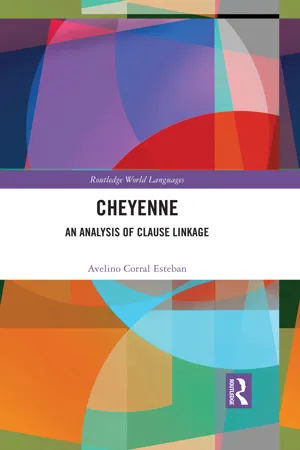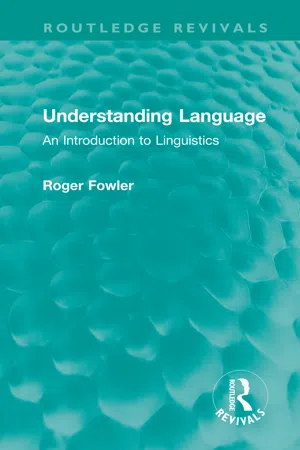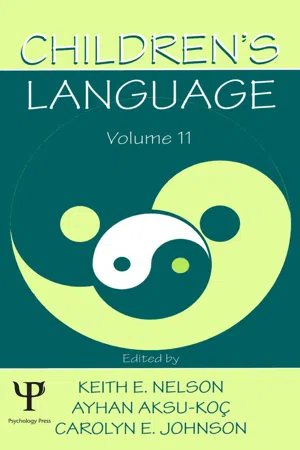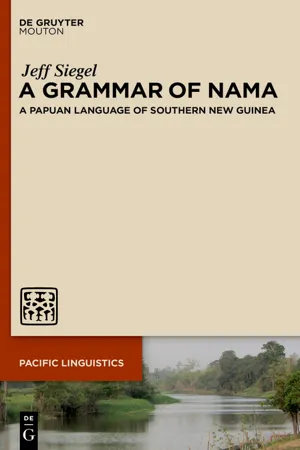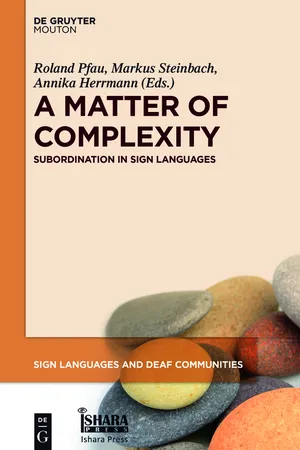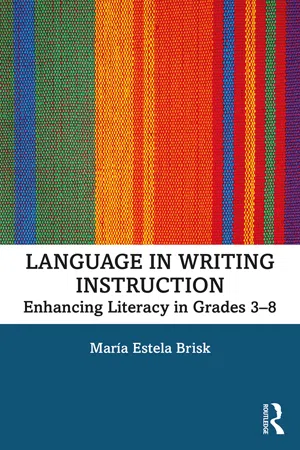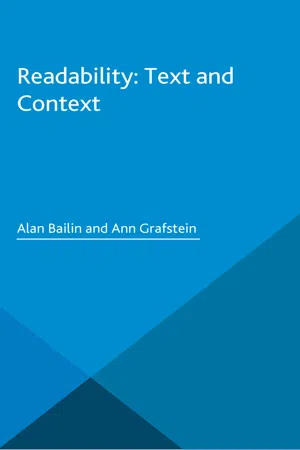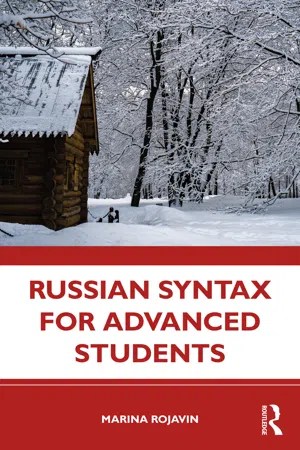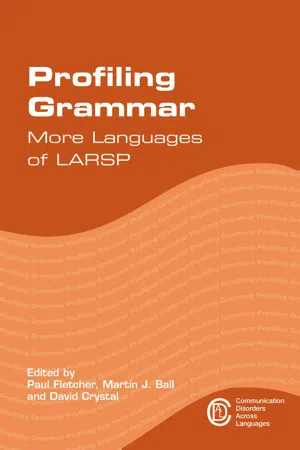Languages & Linguistics
Complex Sentence
A complex sentence is a sentence that contains an independent clause and at least one dependent clause. The independent clause can stand alone as a complete sentence, while the dependent clause relies on the independent clause for its meaning. Complex sentences allow for more complexity and variety in sentence structure, enhancing the expressiveness of language.
Written by Perlego with AI-assistance
Related key terms
Related key terms
1 of 4
Related key terms
1 of 3
9 Key excerpts on "Complex Sentence"
- eBook - ePub
Cheyenne
An Analysis of Clause Linkage
- Avelino Corral Esteban(Author)
- 2023(Publication Date)
- Routledge(Publisher)
3 Clause linkage theory DOI: 10.4324/9781003312314-3 Complex Sentences, or to use a more recent term, ‘clause combining’ (Haiman & Thompson, 1988) or ‘clause linkage’ (Lehmann, 1988), have always occupied an important place in the description of the grammar of different languages. An initial but significant problem faced by studies on Complex Sentences is to find an accurate definition for the term ‘sentence’ in a framework-free manner. Following Fabricius-Hansen and Ramm (2008 : 4), firstly, from a syntactic perspective, a sentence is a basic grammatical unit consisting of a subject and a predicate generally including a clause that involves a finite verb and being ruled by certain syntactic principles (e.g. constituent structure, binding, or movement). Secondly, from a semantic point of view, a sentence can be defined as a string of words containing a single predication consisting of a predicate and a possible set of arguments that makes sense on its own and may be expressed in the form of a statement, question, exclamation, or command - eBook - ePub
Understanding Language
An Introduction to Linguistics
- Roger Fowler(Author)
- 2022(Publication Date)
- Routledge(Publisher)
sevenComplex SentencesAt this point we might remind ourselves of some elementary definitions which are central to syntactic theory. I called chapter 5 ‘Simple sentences’, and chapter 7 brings in the contrast of ‘Complex Sentences’. Simple and complex are not crudely evaluative words, but technical terms which mark a fundamental distinction between types of sentences. A simple sentence is one which is based on a single underlying phrase-marker, or, in traditional terms on just one clause. In turn, the clause is the realization of a semantic structure derived from a single predicate. My decision to begin the discussion of syntax with what might be called simple sentences was not arbitrary, nor was it a decision based on syntactic considerations alone: convenience of syntactic exposition coincided with a semantic criterion. The clause might be thought of as an abstract intermediary step between semantic structure and syntactic surface structure, a representation of the syntax associated with primitive semantic units, a stage in the derivation designed to provide a base on which transformations may operate. Now we already know that the route between meaning and surface structure is a long and complicated one and that it is charted as a sequence of transformations which may make radical alterations to constituent-structure. We would therefore expect the clarity of separation of clauses in deep structure, hence the separateness of single-predicate semantic units, to become obscured under transformation. If we compare, say, John lost his watch with the longer sentence John lost his watch and Paul lost his wallet, there is no difficulty deciding that the first is a simple sentence and the second is complex, by our criteria. But the distinction is not always immediately determinable from the appearance of sentences. In particular, many ostensibly simple sentences turn out, upon closer examination, to be the expression of two predicates and therefore a transformational rendering of more than one clause: John lost his watch and Paul his wallet has had one of its predicates deleted, and if we simply counted verbs we would not realize that this is a Complex Sentence - intuitively it is complex, of course. Less obviously complex as far as our intuitions are concerned are sentences like The fleeing criminal tripped over (which has two predicates) and A tall man entered (which also has two predicates). Finally, closer inspection might show that I have cheated with the example John lost his watch, which, to all appearances simple, might be said to conceal two predicates, the second being hidden beneath the surface of his - eBook - ePub
Children's Language
Volume 11: Interactional Contributions To Language Development
- Keith E. Nelson, Ayhan Aksu-Ko‡(Authors)
- 2005(Publication Date)
- Routledge(Publisher)
The importance of pragmatic and discourse factors related to the input has often been addressed in relation to the acquisition of simple linguistic structures in the early stages. Studies focusing on the facilitative effects of language adults use to address children point to the paucity of complex structures and high frequency of questions (Pine, 1994; Snow, 1986). There are also data showing that structures such as nominal, prepositional, adjectival, and adverbial phrases are used for the first time as dependent on previous adult utterances (Serrat, Capdevila, & Serra, 1994), thus emphasizing the role of conversational context in the acquisition of simple syntactic structures.Given the purpose of the present study and the state of the art in the study of the acquisition of Complex Sentences in different languages, this chapter provides: (a) an outline of the order of emergence and development of different types of Complex Sentences for Spanish and Catalan, focusing both on subordination and coordination, and (b) an analysis of the way first Complex Sentences appear in relation to the conversational context. Our prediction about (b) is that the first ‘Complex Sentences’ will depend on a previous utterance in the conversational context, that is, the main clause in the case of subordinate clauses, or the first sentence in the case of coordinate sentences, will be found in the adult production. Thus, we predict a first period in which children will not produce ‘Complex Sentences’ independent of context but will rely on previous adult utterances. Later on, they will produce complete (or independent) Complex Sentences alongside those which depend on the conversational context.Description of the Syntax of Spanish and Catalan
Catalan and Spanish are Romance languages with similar syntactic and morphological structure. From the morphological point of view, both are infiectionally rich, and the verb is always marked for tense, aspect, mood, person, and number. According to the traditional description, there are three major conjugation classes which contain both regular and irregular verbs. Again in both languages, nouns and adjectives are marked infiectionally for number and gender. From the syntactic point of view, both Catalan and Spanish are configurational head-first languages, both have syntactic w/j-movement, and both are pro-drop. In both, main verbs display the same behavior with respect to the position of adverbs, quantifiers, negation, yes/no - eBook - ePub
A Grammar of Nama
A Papuan Language of Southern New Guinea
- Jeff Siegel(Author)
- 2023(Publication Date)
- De Gruyter Mouton(Publisher)
7 Compound and Complex SentencesThis chapter describes compound and Complex Sentences in Nama, which are both made up of more than one clause, and by definition (see chapter 6), have more than one verb phrase. Compound sentences are comprised of more than one independent clause, while Complex Sentences have an independent clause and one or more dependent (or subordinate) clauses. The first section covers compound sentences, and the following sections deal with the various types of Complex Sentences classified by type of subordinate clause: adverbial clause, relative clause, complement clause and focus marking clause.7.1 Compound sentences
As already mentioned, compound sentences consist of two or more independent clauses. They can be joined by one of the coordinating conjunctions introduced in section 6.1.2: a ‘and’ (conjunctive) and o ‘or’ (alternative):(805)fèyo nuot kaflangè a nu fèyo nu-ot k-afèli-Ø-ang-è a nu then water-all β.ØP-move-pfv.nd-inc-2|3sg SA and water ‘then she went to the river and fetched water.’tènmukangè. (MD13(1)) t-n-wukè-Ø-ang-è β.3sg P-ven- fetch-pfv.nd-inc-2|3sgA (806)yerayènd a limanègh y-werè-Ø-ay-nd a limán-gh α.3sgP- hold-pfv.nd-rem.punc-2|3nsgA and pull-nom ‘they caught it and started pulling it.’yafngoyènd. (YD11(2)) y-wafngo-Ø-ay-nd α.3sgP- start-pfv.nd-rem.punc-2|3nsgA (807)yèna so yènkmare o so yèna so yèn-kèmè-ar-e o so here fut α.1nsgS P - be.lying.down-du.pa-pfv.du or fut ‘will we (2) sleep here or will we go back?’nangowèm? (TE11(1)) n-ango-Ø-wè-m α.ØP- return-ipfv-du-da-1nsgS A (808)Coordination can also be unmarked, as in comparative constructions:wagh so yufanat o si wagh so y-wufar-ta-t o si singsing fut α.3sgP- sing.out-ipfv.nd-2|3nsgA or story so norayat. (B&B:167) so n-oray-ta-t fut α.ØP- say-ipfv.nd-2|3nsgS A ‘they will sing out a singsing or tell stories.’ - eBook - ePub
- Roland Pfau, Markus Steinbach, Annika Herrmann(Authors)
- 2016(Publication Date)
- De Gruyter Mouton(Publisher)
Complex Sentences in sign languages: Modality – typology – discourse Roland Pfau and Markus SteinbachAbstract
Sign language grammars, just like spoken language grammars, generally provide various means to generate different kinds of complex syntactic structures including subordination of complement clauses, adverbial clauses, or relative clauses. Studies on various sign languages have revealed that sign languages use modality-independent strategies, i.e. strategies which are also available in spoken languages, to mark such complex subordinated structures. However, complex clauses in sign languages also display some interesting modality-specific properties, which are not attested in spoken languages. Therefore, the study of complex syntactic structures in the visual-gestural modality adds to our understanding of linguistic variation in the domain of subordination. Moreover, it offers new empirical and theoretical evidence concerning possible structures and functions of Complex Sentences in natural languages. In this introductory chapter, we focus on five aspects relevant to the investigation of subordinated clauses – complexity, modality, typology, discourse, and grammaticalization – and sketch how the study of subordinate structures in sign languages contributed, and still contributes, to the field of sign language linguistics and linguistic typology.1. Introduction
According to a long-standing linguistic tradition, recursivity is a hallmark of natural languages (Hauser et al. 2002), next to other defining features such as, for instance, duality of patterning (Hockett 1960) and anaphoric reference. Recursivity implies that a certain rule can reapply to a construction that has itself been derived by that rule; for instance, a verb may take a sentence as complement, which in turn contains a verb with a sentential complement, and so forth.1 - eBook - ePub
Language in Writing Instruction
Enhancing Literacy in Grades 3-8
- María Estela Brisk(Author)
- 2020(Publication Date)
- Routledge(Publisher)
3Language to Express Complex Ideas
A s students mature they learn and want to express more complex ideas and relationships. Their writing evolves over time with maturity, out of school literacy experiences, and instruction in school. Early in their writing children use simple sentences with noun groups that include just a pronoun or a noun. The next stage is to include a modifier after the verb to be . Eventually the modifier moves next to the noun. With respect to clause complexes, which are sentences with more than one clause, children start by connecting simple sentences mostly with and , as well as but , and so . Late elementary school students’ language explodes with many more clause complexes that include both coordinate and subordinate clauses. Clauses are also formed with non-conjugated (non-finite) verbs, using the infinitive, gerund, or past participle. The first type of clauses with non-conjugated verbs are of purpose with the infinitive. Those with the gerund and past participle appear much later.The features of language characteristic of written language do not emerge until middle and high school age students. This development includes the use of simple sentences with extended noun groups that include embedded clauses, the use of nominalization, and the use of prepositional phrases that pack information (see Table 3.1 - eBook - ePub
- Alan Bailin, Ann Grafstein(Authors)
- 2016(Publication Date)
- Palgrave Macmillan(Publisher)
3
Grammar and Readability
In this chapter we look at grammatical structure and readability, first in relation to syntax (the order and structure of the words in a sentence), and then in relation to morphology (the internal structure of words). We will consider both syntax and morphology from the perspective of linking and ambiguity.Syntactic complexity
Readability formulas, as we have seen, predict that a text with longer sentences will be difficult to understand because they are more complex. However, length and complexity in grammatical terms are not equivalent. In purely grammatical terms, complexity refers to the depth of the syntactic structure. Sentences with clauses or phrases inside other clauses or phrases of the same category, for example, are more complex structurally than sentences that consist of several independent coordinate structures.An examination of even a few examples shows clearly that sentence length is not equivalent to syntactic complexity. While in (1) there are no clauses or phrases inside of other clauses or phrases of the same category, the same is not true of (2). In (2) we have a subordinate clause inside of another subordinate clause (whenever he tried inside of that whenever he tried he failed ) and a small noun phrase inside of a larger noun phrase. This larger noun phrase is made up of the smaller noun phrase and a subordinate clause (Jamie inside of Jamie, who was always getting into trouble ).(1) John, Mary, and the two children soon found both the house and the surrounding neighborhood somewhat tawdry, and they all wished to move somewhere else and begin a new life. (2) Despite the fact [that [whenever he tried] he failed], [[Jamie], [who was always in trouble]], wished with all his heart, to lead a life which was free of criminal associates.Sentence (2) has the same number of words (30) as sentence (1), but (2) has four subordinate clauses while (1) has not a single one. Moreover, not only is it possible to have two sentences of the same length which have different levels of grammatical complexity, but it is quite possible to have a shorter sentence which is far more complex than a longer one. Consider the following: - eBook - ePub
- Marina Rojavin(Author)
- 2022(Publication Date)
- Routledge(Publisher)
PART IIIComplex Sentences
DOI: 10.4324/9781003174738-12Complex Sentences сложноподчинённое предложéние include two or more simple sentences, one of which is principal while the others are subordinate. These sentences cannot exist separately; they depend on each other. Он с ýжасом уви́дел, что попáл в незнакόмое мéсто. He saw with horror that he had strayed into an unfamiliar place. Subordinate conjunctions (что, чтόбы, как, éсли, так как, and others) or connective words (котόрый, какόй, чей, где, кудá, откýда, почемý, and others) join a subordinate clause to the principal one. Complex Sentences can contain explanatory, attributive, and adverbial clauses.Passage contains an image
10 EXPLANATORY CLAUSESDOI: 10.4324/9781003174738-13Main topics
- Words, to which explanatory clauses refer
- The conjunctions что, бýдто, как, чтόбы, как бы не, чтόбы не, ли
- The connective words кто, что, какόй, как, где, кудá, откýда, почемý, зачéм
- То in main clauses
Explanatory clauses объяснúтельные придáточные предложéния usually refer to a verb, a participle, a verbal adverb, or a short adjective in a main clause. Explanatory clauses function as subjects or objects and fill a missing gap in a main clause, explaining what was said in main clauses; they answer the questions of cases. Ромáн попроси́л Áнну, чтόбы онá рассказáла о своéй поéздке. Roman asked Anna to talk about her trip. О чём Ромáн попроси́л Áнну? What did Roman asked Anna about? The words in main clauses to which explanatory clauses are attached indicate speech, thoughts, feelings, perceptions, or wishes. Explanatory clauses mainly follow main clauses, although they can be placed before them. Что дéлать в э́том слýчае, мы не имéли представлéния. We had no idea what to do in this case - eBook - ePub
Profiling Grammar
More Languages of LARSP
- Paul Fletcher, Martin J. Ball, David Crystal(Authors)
- 2016(Publication Date)
- Multilingual Matters(Publisher)
+ . This is to enable us to recognize, and record in the profile, the facility afforded by the language to the speaker to construct multiple sentences either of two clauses, or of more than two:Coord. 1: you push it and it goes upCoord. 1+ :you push it and it goes up and then it comes down againSubord.A 1: he bit his tongue while he was eatingSubord.A 1+ :When Essie visits we sleep on the floor while we take napsPostmod.cl. 1: This is the cat that chased the ratPostmod.cl. 1+ :This is the cat that chased the rat that ate the cheese(2)Although the constructions in Figure 13.1 fall under the same general label of ‘Complex Sentences’, they differ widely in form and function:•Coordinate or conjoined sentences link distinct clauses which represent linked propositions:you push itand it goes up S V O S V A •In Subordinate A (adverbial) constructions, a main clause has as one element of its structure another clause, usually linked to the main clause by a subordinating marker such as when , while , if , because , which indicates the semantic relationship between the clauses – temporal, conditional, causal, etc.he bit his tongue while he was eating
•In Subordinate O constructions, a clause is embedded as the object argument of the verb in the matrix clause:S V O A s S V I think we need a restS V O S V O (3)The post-modifying or relative clause belongs to a group of constructions that come in varying forms but all share a defining feature – i.e. in clausal form they serve to modify a nominal in a matrix (main) clause, by giving specifying or limiting information about the referent the nominal relates to:
Index pages curate the most relevant extracts from our library of academic textbooks. They’ve been created using an in-house natural language model (NLM), each adding context and meaning to key research topics.
Explore more topic indexes
Explore more topic indexes
1 of 6
Explore more topic indexes
1 of 4
